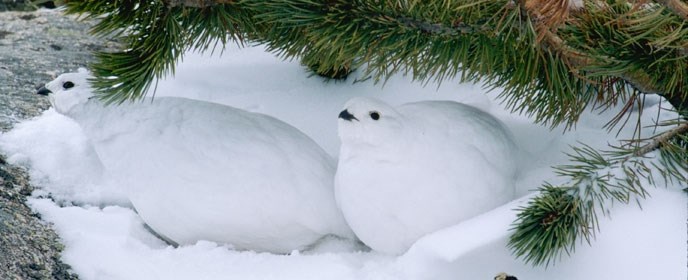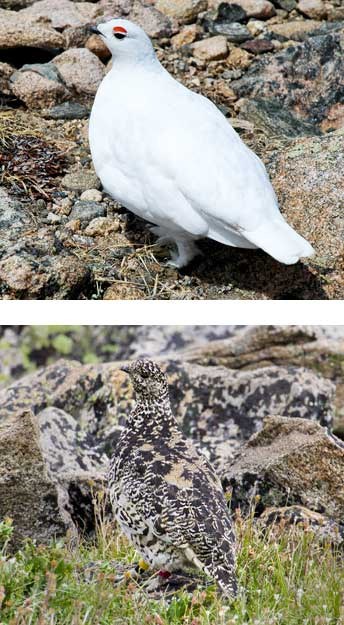
NPS 
NPS/Jon Olsen White-tailed Ptarmigan - Lagopus leucuraLength: 1.8-12.2 in. (30-31 cm) - Weight: 11.6-16.9 oz. (330-480 g) Physical DescriptionThe smallest grouse in North America, the White-tailed Ptarmigan is pure white in the winter, and streaked brown and gray during the summer. The tail remains white throughout the year. Breeding males are mostly grayish-brown, with broad band of black markings across chest. Eye combs are red. The non-breeding male is completely white with black eyes and bill. Breeding females show finely barred plumage, with yellowish tint contrasting with black or dark brown. The non-breeding female is completely white with black eyes and bill. HabitatWhite-tailed Ptarmigan breed in alpine habitats at or above treeline. Nest sites are located in snow free rocky areas or near alpine willow shrubs or spruce krummholz trees. In summer, males and broods are often found near receding snowfields and rocky areas at higher elevations. In winter, this species occupies willow-dominated basins or riparian areas at or below treeline where snow is available for roosting. BehaviorThese birds generally prefer walking over flight, perhaps as a means to conserve energy in their unforgiving habitat. Once pair bonds are formed, the male shadows the female constantly until she begins to incubate the eggs. These pair bonds can last up to 3 months within a season. This is typical of the grouse family, and often the same pair bonds will reform the following year. During the fall and winter, they can be found in loose flocks, but are more territorial during the breeding season. They commonly make use of willows and moist vegetation at the edge of snowfields. In winters with heavy snowfall, they will often move below the timberline. DietThe White-tailed Ptarmigan predominantly eats buds, leaves, and seeds. In the summer, this staple diet is supplemented with fruit, flowers, and insects. They are highly dependent on willow, especially in the winter. They have been known, like other members of this group, to swallow grit to help grind coarse food in their gizzards. NestingThe male guards the female while she selects a ground nesting spot in a meadow or rocky area. The female scrapes the ground pulling vegetation around her in a rim. She keeps adding to this rim until she begins to incubate the eggs, at which point, the male ceases to guard her. Eggs & IncubationWhite-tailed Ptarmigan eggs are light cinnamon, showing dark spots toward the time of hatching. Within 6-12 hours of hatching, the female leads her clutch of 4-8 chicks to food sources where they are able to feed themselves. They do not return to the nest. Migration StatusWhite-tailed Ptarmigans are permanent residents, although they do tend to move to lower elevations where they can find vegetation to feed on during the winter. Even at these lower elevations, however, they remain above the deep snowline. Females move farther down slope than males, although both arrive in wintering areas in early-mid October. Males arrive on the breeding grounds in late April and females follow in mid-May. Interesting FactsThe White-tailed Ptarmigan leads a very sedentary lifestyle in winter. They conserves precious energy by avoiding flight and often roost in snow banks. Warm weather may stress the White-tailed Ptarmigan. It can be seen bathing in snow when the temperature is higher than 21° C (70° F) |
Last updated: May 3, 2018
